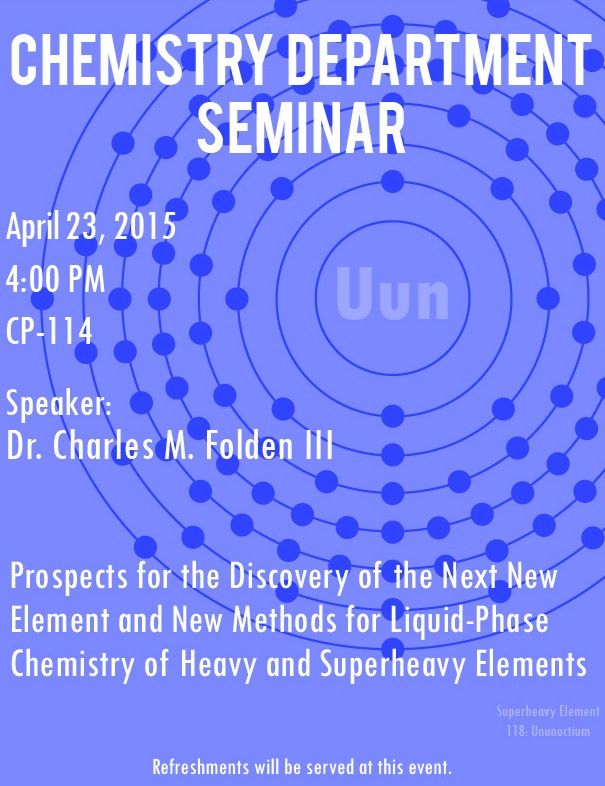Analytical Chemistry Seminar
----------
Cumulative Exam Review
Somin Park will be presenting this week's seminar. She will be introduced by Alex Boehm.
Course Instructor: Dr. Kenneth Graham
----------
Cumulative Exam Review
Somin Park will be presenting this week's seminar. She will be introduced by Alex Boehm.
Course Instructor: Dr. Kenneth Graham
----------
This event was originally scheduled on February 20, 2015 but was rescheduled due to weather.
Dr. Charles M. Folden III will be presenting a seminar titled Prospects for the Discovery of the Next New Element and New Methods for Liquid-Phase Chemistry of Heavy and Superheavy Elements.
Abstract: Experiments in recent years have produced new spherical, shell-stabilized superheavy elements through Z = 118 in complete fusion neutron-evaporation reactions using projectiles of 48Ca reacting with actinide targets. Unfortunately, projectiles with higher atomic numbers will be required for the discovery of heavier elements due to a lack of available target materials. Recent experiments in my group at Texas A&M University have studied the effect of varying the projectile in so-called analog reactions, which also produce spherical, shell-stabilized nuclei, but with much larger cross sections. The data show a substantial reduction in cross section when other projectiles are used compared to the reactions of 48Ca with the same targets. A simple theoretical model has been developed which suggests that the probability of compound nucleus formation and the survival of compound nuclei are both negatively affected by the change from 48Ca. In these reactions, significant collective effects decrease the probability that the excited nucleus will “survive” against fission and defy the assumption that strong shell-stabilization will increase the cross section. These results suggest that the production of new spherical, shell-stabilized superheavy elements with Z > 118 could be very difficult.
Faculty Host: Dr. Steven Yates

----------
CHE 572-001 CP-114B
Karl Hempel, introduced by Grant Palmer
Calvin Hong, introduced by Sunyoung Lee
Maxwell Ain, introduced by Santiago de Leon
Course Instructor: Dr. Kenneth Graham
CHE 572-002
Dr. Testa's group meets in CP-111.
Jared Phillips - Addicted: The Chemical Effects of Excessive Fat and Sugar Consumption on the Brain
Kaitlin Walker - Rain, Rain, Go Away
Zachary Sweeney - Total Synthesis of Biologically Active Alkaloids via Cascade Cyclization
Dr. Yates' group meets in CP-114A.
Nicholas English - Thiomersal and its Role in Vaccines
Thomas Bailie - TBA
Course Instructor: Dr. Stephen Testa
----------
CHE 572-001 CP-114B
Check back soon for more details.
Course Instructor: Dr. Kenneth Graham
CHE 572-002
Dr. Testa's group meets in CP-111.
Dr. Yates' group meets in CP-114A.
Course Instructor: Dr. Stephen Testa
Workshop on Networking and Making the Most out of Conferences (co-organized with AGSA)
Spacetime and global symmetries play a fundamental role in modern physics. Among other things, they lead to selection rules and non-renormalization theorems which hold for any theory with that symmetry. Remarkably, the spacetime symmetries of Galilean-invariant, non-relativistic theories have only been understood in the past year. I will discuss this progress as well as some implications for transport phenomena and a new spin on Schrodinger-invariant field theories.
----------
Dr. Lynn Loo of Princeton University will be presenting a seminar titled Structural development in molecular semiconductors for thin-film electronics. To read the full abstract, click here.
Faculty Host: Dr. Chad Risko

----------
Dr. Kyle Plunkett of Southern Illinois University will be presenting a seminar titled Synthesis of CP-PAH Based Electron Accepting Materials and Highly-Ordered Polymer Nanostructures.
Abstract: This presentation will highlight two recent results from my laboratory in which we have 1) synthesized new electron accepting materials based on cyclopentafused-polycyclic aromatic hydrocarbons (CP-PAHs) and 2) created highly ordered polymer nanostructures via polychromophore architectures. In the first part of the talk, both small-molecule and polymeric electron acceptors that incorporate CP-PAH scaffolds will be described. Our synthetic strategy utilizes scalable processes to create halogenated CP-PAHs that can participate in a variety of palladium-catalyzed coupling chemistries. This approach allows easy modulation of the frontier orbital energies and thus provides access to tunable materials. In the second part of the talk, I will show how the chromophore length in a conjugated polymer composed of both rigid and flexible segments directly influences the anisotropy at the single polymer level. Our efforts to translate the packing order from the single polymer chain to polymer aggregates and films will be described.
Faculty Host: Dr. Susan Odom
Course Instructor: Dr. Mark Watson